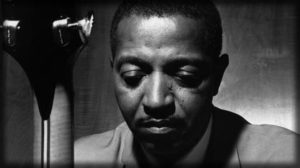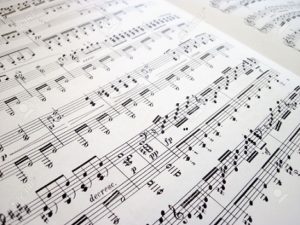
Jazz improvisation can seem pretty daunting at first glance: the countless scales, arpeggios, and use of flat keys, may seem like starting all over again. But in fact, it is really just an extension of what you already know! The hardest part is laying down the foundation which you likely already have.
In this article, you'll learn about the various jazz guitarists of different eras and jazz sub-genres. Each guitarists take a different approach to the guitar, but remain the same in the fact that it is all built on that foundation of basic improvisation. The role of jazz improvisation is to expand on the knowledge you have already learned from studying rock, pop, or contemporary guitar.
What do I mean by basic improvisation? I am talking about playing any major or pentatonic scale, then noodling over a blues song or perhaps your favorite rock tune. The concept is already there; you hear something in your head and you play it. The only difference in jazz music is that we use these scales in a different way to create different sounds and emotions.
Now you may ask yourself, why would I want to learn jazz improvisation?
As a genre, jazz is forever changing. It is one of the oldest forms of contemporary music, yet jazz of today is some of the freshest and in today's culture, it is becoming more and more a part of popular music. More musicians, particularly in the RnB and Hip Hop world, are experimenting with different, more sophisticated sounds in their music, and people are loving it. Even if the music is something that you may pass on, the techniques are timeless.
For a rock musician, having your hands around that curley jazz language can really do amazing things for your soloing and just writing songs in general. It will open you up to new keys and give you fresh ideas to bring to your band.
I have handpicked ten guitarists that I think really shape jazz guitar music. Other than jazz, these guitarists also play different genres, from rock and blues, to traditional Latin music.
My article will give you a great insight into how broad jazz can be and all the possibilities within it. For each artist, I have transcribed a lick for you to learn that best represents their style of improvising. Learn how to play these licks and you will be well on your way to becoming a jazz master!

1. Django Reinhardt (1910-1953): Romanian gypsy known for his inspirational handicap and the creation of the gypsy jazz genre.
Django is possibly the most inspiring and greatest guitarist to ever live. In his teen years, he lost two fingers in a caravan fire requiring him to re-learn the guitar from scratch using only three fingers!
He managed this by barring his index finger across the fretboard and using arpeggios that used two notes per string. Django, along with the violinist, Stephane Grappelli, went on to become the creators of Gypsy Jazz. This genre was the early form of swing music in France often played by guitars, double bass, violin, and clarinet and used as dance music in clubs.

The chosen lick is from “In Your Own Sweet Way” on Django Reinhardt and Stephane Grapelli’s This is the Essence of Gypsy Jazz at 2:17. This album has a sound that is closely associated with 20th-century Paris and features Django and Stephane playing their classic swing tunes.

Listen to the heavy swing and vibrato that Django uses on his melodies. The lick is in the classic Django style and simple, it’s just a major arpeggio! Use your index finger to bar across the seventh fret and add vibrato to get that gypsy jazz sound.

2. Freddie Green (1911-1987): Early big band rhythm guitarist chosen for his development of the famous “Freddie Green” strumming pattern and his influence on the guitar’s role in a rhythm section.
Although not so much a solo guitarist, Freddie Green changed the way many guitarists approach accompaniment. The “Freddie Green” strumming technique is to play straight quarter notes evenly.
Sounds simple right?
Yet, the voicings he used and the way he hit the strings make this technique one of the hardest strumming patterns to properly master. It takes a long time to develop the right feel and groove to really create that swing sound. Freddie was known for having an incredibly high action (string height) on his acoustic guitar in order to be heard over the full big band.
The must-listen album is Count Basie: Live at the Sands (Before Frank) - this features Freddie’s rhythm playing and is known as some of the hardest swinging big band recordings of all time.
The chosen lick is not a lead guitar lick as such--but the classic ii V I Freddie Green chord voicing using the drop 3 chords heard throughout all his recordings. This is coupled with his Freddie Green strumming pattern which is a great way for you to practice your swing. Play to a metronome and along to the album and you will develop a great sense of rhythm.

Listen hard for the chank chank of his acoustic archtop guitar in the background giving the band some heavy swing.

3. Johnny Smith (1922-2013): An American guitarist chosen for his lightening speed and technical ability.
Johnny Smith was the coolest guitarist of his time, known equally for his small, smokey jazz club gigs as he was for his work on television and with the New York City Philharmonic. Johnny was a true master of technicality on the instrument. He could run any arpeggio or scale up and down the neck with tremendous speed and articulation making him an idol for many young players. Above all this, Johnny could read music amazingly fast!
The chosen lick is from the track “Stranger in Paradise” at 1:40 from the album Walk don’t run. This lick is a great introduction to the bebop scale and is a very clean line made up of 16th notes. In this album, you can hear Johnny play chordal passages fluently with his trio.

Listen carefully for all the scale passages and how evenly he executes them.

4. Wes Montgomery (1923 - 1968): Wes is one of the most famous jazz guitar players, chosen for his unorthodox picking and unique jazz guitar techniques.
No pick you say? Wes didn’t need it, or maybe he just kept losing it, we shall never know. Regardless of this, Wes Montgomery learned to use his thumb to play those astounding be-pop licks at lightning speed. All these skills came from a man who did not start learning the guitar until age 20! Another incredibly inspiring guitarist.
Listen to his album, The Incredible Jazz Guitar of Wes Montgomery, so many great licks in one album! Check out his sweep picking lines that use only his thumb and listen to his use of octaves.
The chosen lick is from the track “Our Own Sweet Way” at 2:17. This is made up of a susb9 arpeggio and based in a minor key.

Pay careful attention to which notes he accents and hammers on. This gives the lick its swingin’ sound and jazzy texture.
Do check out this solo transcription for Wes’s Gone With the Wind by one of our instructors Tom Coppin.

5. Antonio Carlos Jobim (1927 - 1994): Selected for bringing Bossa Nova as we know it to the world of jazz standards.
Jobim is probably best known as a composer and on the gig you may often hear “let’s just play a Jobin tune” when someone has forgotten to write a set list. This is because his songs have completely dominated the Bossa Nova repertoire of jazz standards.
From hit tunes like “The Girl from Ipanema” to “How Insensitive,” these are the must know tunes for jazz guitarists. Jobin’s form of accompaniment is a widely used rhythmic technique with all jazz guitarists when playing Bossa Nova. It consists of an alternating bass note, with the chord played on top in a Bossa Nova rhythm.
Listen to Antonio Jobim’s Album Finest Hour, featuring all of his most famous compositions. These are essential for any jazz musician. An essential jazz improvisation lick is Jobim’s comping technique the ‘Bossa Nova’ Rhythm in a ii V I. You can hear this in virtually every composition of his. Practice each right hand finger separately first as it can be difficult getting the coordination.


6. Jim Hall (1930 - 2013): Chosen for his influence on the role of the guitar in jazz and his individual sound.
In the jazz world, Jim Hall must be one of the most exciting musicians on guitar. His improvisation and philosophy on the instrument have been the topic of countless theses and his international teaching have resulted in his style becoming a standard for all modern guitarists. As a guitarist, it is great to check out his duo work with bassist Ron Carter and pianist Bill Evans. Jim takes a minimalistic approach to the guitar, but when needed he can really let it rip! He has worked in big bands, TV, and as a sideman for countess touring artists.
In his album Undercurrent, Jim teams up with pianist Bill Evans to create one of the most exciting duo albums of any jazz musician. The almost Classical approach of the arrangements makes this a great one for transcriptions. Listen to the way he responds to Bill’s improvising by playing melodic and rhythmic ideas back to him.
The chosen lick from this album is “My Funny Valentine” at 2:01. This is a very common approach to dominant chords and Jim uses it very convincingly.

Practice using a sweep picking motion for the arpeggios and listen to where he uses hammer ons to link together notes.

7. John Scofield (1951 - present): Included here for his rock, blues, and funk take on jazz fusion.
Nicknamed the man of groove, when anyone says jazz fusion, I think Scofield. His impeccable sense of rhythm and phrasing has made him a legend in the world of fusion. John is well known for using overdrive and bluesey licks to get a huge rock sound out of his Ibanez guitar. During his long reign as the world's most iconic jazz-rock guitarist, he has played with the likes of Miles Davis and Jaco Pastorius.
John Scofield’s album A Go Go is a perfect collection of grooves and blues licks to leave you inspired for years. I continually come back to this album for ideas for funk and RnB solos. Listen for the way he places his notes rhythmically to make them groove. This attention to groove is something that puts him beyond many other rock players.
The chosen lick is from the song “Chicken Dog” at 1:48. This is a great funk lick using the pentatonic scale and chromaticism.

Try it with a little bit of distortion to give you that rock sound.

8. Pat Metheny (1954 - present): Selected for his use of midi technology and pop-style composition
Pat Metheny grew into the jazz fusion scene, but not from the blues rock side that Scofield did. He has a very melodic approach to the guitar and is known as one of the most innovative with his use of midi, controlled by his guitar. Pat uses his guitar to trigger midi synthesizers that he himself has developed. He even built an entire band made out of instruments that played themselves! Upon all this you can clearly hear his pop influence in the way he constructs melodies.
Possibly the most unique album on the list is Orchestrion as all the instruments (except Pat’s guitar) are played by robots. This album was one of a kind when it was released and features some of Metheny's most extravagant compositions yet.
The chosen lick is from the track “Antonia” at 2:20.

Metheny's pop-esk compositional style lacks traditional ii V progressions, so this is a great line that leads into the VI chord. This is something very useful if you are playing more modern jazz or even pop music.

9. Kurt Rosenwinkel (1970 - present): Included for his use of interesting effects pedals and a modern take on jazz harmony.
From his unorthodox improvisation to the crazy pedals effects he uses, Kurt has made his persona as the ‘sound of modern guitar.’ Apart from being the most unique sounding musician out there he has certainly spent a lot of time studying the greats. You can always find Kurt working on something new and wacky.
His album, Our Secret World holds a number of Kurt Rosenwinkel compositions played with the Orquestra Jazz de Matosinhos, a freelance Orchestra from Portugal. This is a great depiction of Kurt’s improvisational sound and has some amazing guitar solos that give a new insight on improvisation.
The lick is from the title track “Our Secret World” at 2:46. Again, this is not a ii V lick, but a hip pentatonic pattern that Kurt is known for.

This one sounds really modern, but is actually quite simple to grasp as it uses only the pentatonic scale. Try hammering wherever you have two notes on a string.

10. Julian Lage (1987 - present): Chosen for his unique fusion of jazz and bluegrass with acoustic guitar.
Julian Lage is a modern guitar prodigy. For anyone who is into finger picking or country style guitar, Julian is a must to check out. He effortlessly blends bluegrass melodies with jazz voicings and a country feel, all on his vintage Gibson L5. Julian is probably the youngest jazz guitar legend on the scene at the moment and is one to seriously watch as he will no doubt change the way many approach the guitar.
His album World’s Fair is a series of beautiful acoustic guitar compositions that although may be near impossible for us to play, can still be an inspirational endeavour to attempt. Even hearing this album may lead to new ideas for songwriting as there is nothing quite like it out there.
The lick is from the track “Day and Age” at 0:46. It is a very simple country style line that when executed well can sound very melodic.

This lick is so simple that you really must listen to how he picks each note. This is a great example of how your touch and rhythm can be much more effective than your choice of notes.
Coda
This brings us to the end of our list, all these guitar players have shaped jazz guitar as we know it today and continue to create new and exciting things. You may find some you like more than others, but this part of finding your own style.
After practising these licks, you will get an idea of the improvisational language that has shaped the world of jazz guitar. Keep exploring these guitarists and work on transcribing licks of your own. The more music you listen to, the more your mind will pick up on the nuances of each different recording and how each musician approaches rhythm and phrasing.
The best way to learn the jazz language is to find things you like and then transcribe them yourself, this way when you start learning the theory it will all seem relevant and easy to understand. You will find that from transcribing an array of different styles that new ideas will come out of you naturally and you will start to find your own voice. Our brain will automatically discard the stuff we don’t like and internalize the stuff we do, giving you a unique improvisational sound.
The next step will be to start learning which scales to use and where and then you will start being able to create licks of your own!
Contact Us For More Information
Feel free to reach out to us if you'd like more advice on how to learn & play the jazz guitar.
Ready to learn music?
Start learning with our 30-day free trial! Try our music courses!
About Liberty Park Music
LPM is an online music school. We teach a variety of instruments and styles, including classical and jazz guitar, piano, drums, and music theory. We offer high-quality music lessons designed by accredited teachers from around the world. Our growing database of over 350 lessons come with many features—self-assessments, live chats, quizzes etc. Learn music with LPM, anytime, anywhere!











Chuck Wayne and Joe Pass?!
Jobim was more of a composer (mostly bossa novas).
I would take him off the list and add Chuck Wayne or Joe Pass.
PHILIP CATHERINE?!!
I suggest that you listen to “LIVE AT FLAGEY”.
He can combine jazz/fusion and just jazz in one song quite easily.
The memory work on his part is incredible and the two keyboardists really adds some punch!
This guy is unbelievable!!!!!!!!!!!!!!!!!!
Who has ever heard of ROLAND BALOGH???
https://www.youtube.com/watch?v=rFq6RnQID6g
JAMES MULLER FROM AUSTRALIA!!!!!
https://www.youtube.com/watch?v=jwmBeDY_5RM
BTW, I played with LORNE LOFSKY (guitar) and OSCAR PETERSON at YORK UNIVERSITY in the mid 1980s!!
OFF TOPIC BUT STILL INTERESTING!!:
FOR LYDIAN MODE FANS:
1) The theme song from the JETSONS.
2) THE WEST WING: The theme song at the END of an episode!!